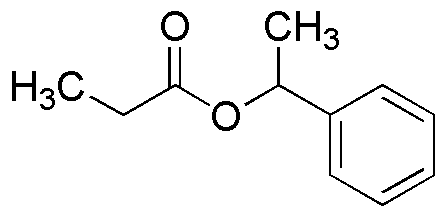1-Phenylethyl propionate is widely utilized in research focused on:
- Fragrance Industry: This compound is commonly used as a flavoring agent and fragrance in perfumes and cosmetics, providing a sweet, fruity aroma that enhances product appeal.
- Food Industry: It serves as a food additive, imparting pleasant flavors to various food products, making it popular in the formulation of candies, baked goods, and beverages.
- Pharmaceuticals: In drug formulation, it acts as a solvent or carrier for active ingredients, improving the stability and bioavailability of certain medications.
- Research Applications: It is used in organic synthesis and chemical research, allowing scientists to explore new chemical reactions and develop innovative compounds.
- Cosmetic Formulations: The compound is incorporated into skincare products for its emollient properties, enhancing texture and moisture retention in creams and lotions.
General Information
Properties
Safety and Regulations
Applications
1-Phenylethyl propionate is widely utilized in research focused on:
- Fragrance Industry: This compound is commonly used as a flavoring agent and fragrance in perfumes and cosmetics, providing a sweet, fruity aroma that enhances product appeal.
- Food Industry: It serves as a food additive, imparting pleasant flavors to various food products, making it popular in the formulation of candies, baked goods, and beverages.
- Pharmaceuticals: In drug formulation, it acts as a solvent or carrier for active ingredients, improving the stability and bioavailability of certain medications.
- Research Applications: It is used in organic synthesis and chemical research, allowing scientists to explore new chemical reactions and develop innovative compounds.
- Cosmetic Formulations: The compound is incorporated into skincare products for its emollient properties, enhancing texture and moisture retention in creams and lotions.
Documents
Safety Data Sheets (SDS)
The SDS provides comprehensive safety information on handling, storage, and disposal of the product.
Product Specification (PS)
The PS provides a comprehensive breakdown of the product’s properties, including chemical composition, physical state, purity, and storage requirements. It also details acceptable quality ranges and the product's intended applications.
Certificates of Analysis (COA)
Search for Certificates of Analysis (COA) by entering the products Lot Number. Lot and Batch Numbers can be found on a product’s label following the words ‘Lot’ or ‘Batch’.
*Catalog Number
*Lot Number
Certificates Of Origin (COO)
This COO confirms the country where the product was manufactured, and also details the materials and components used in it and whether it is derived from natural, synthetic, or other specific sources. This certificate may be required for customs, trade, and regulatory compliance.
*Catalog Number
*Lot Number
Safety Data Sheets (SDS)
The SDS provides comprehensive safety information on handling, storage, and disposal of the product.
DownloadProduct Specification (PS)
The PS provides a comprehensive breakdown of the product’s properties, including chemical composition, physical state, purity, and storage requirements. It also details acceptable quality ranges and the product's intended applications.
DownloadCertificates of Analysis (COA)
Search for Certificates of Analysis (COA) by entering the products Lot Number. Lot and Batch Numbers can be found on a product’s label following the words ‘Lot’ or ‘Batch’.
*Catalog Number
*Lot Number
Certificates Of Origin (COO)
This COO confirms the country where the product was manufactured, and also details the materials and components used in it and whether it is derived from natural, synthetic, or other specific sources. This certificate may be required for customs, trade, and regulatory compliance.


